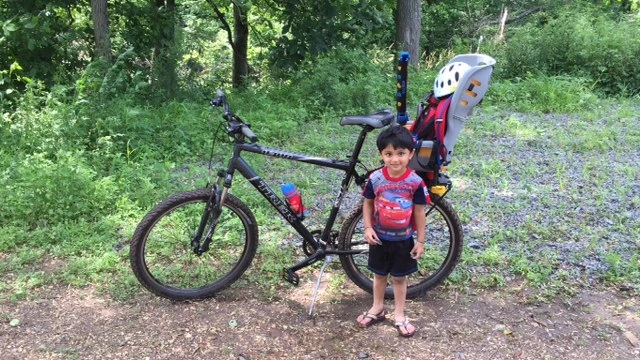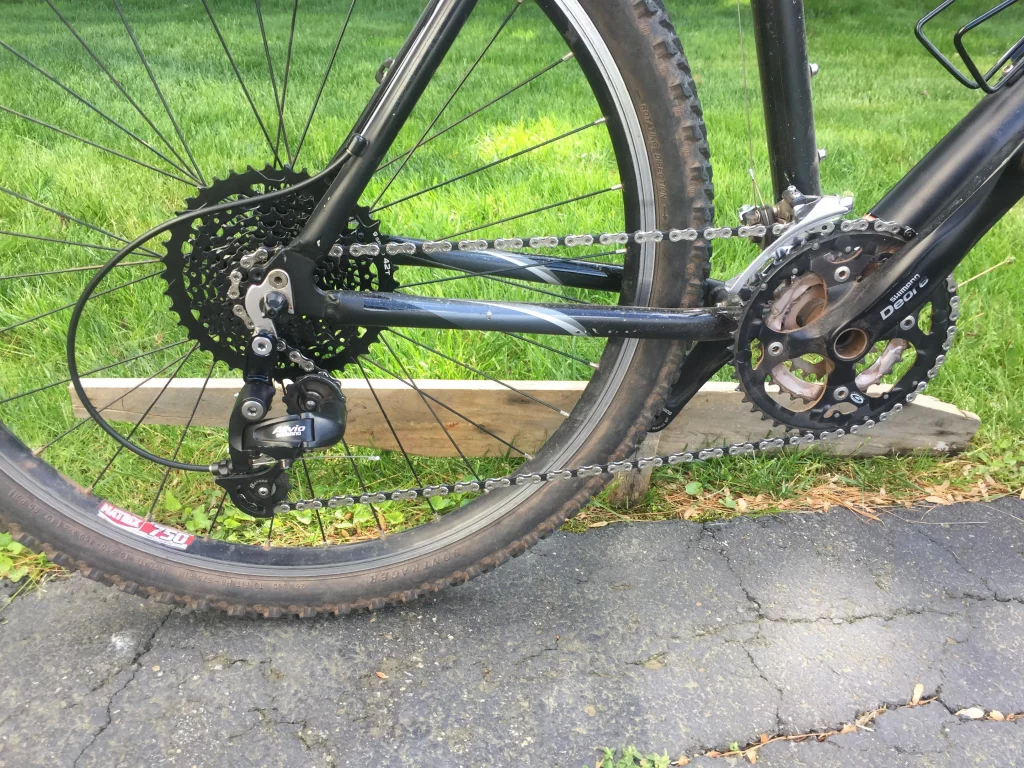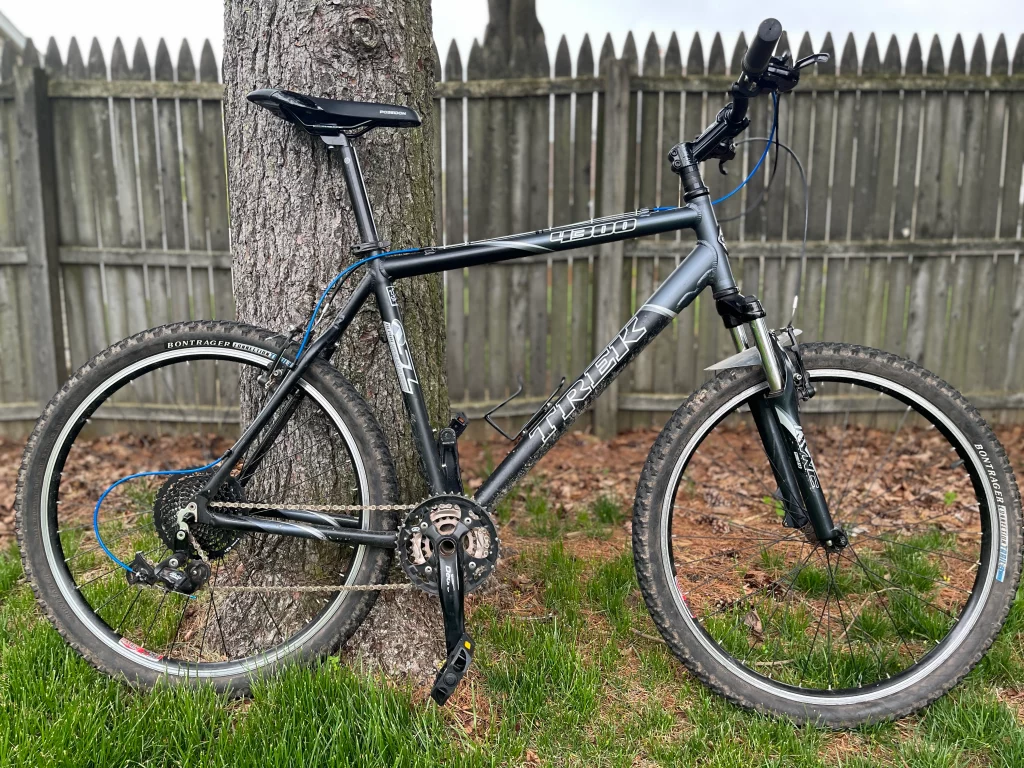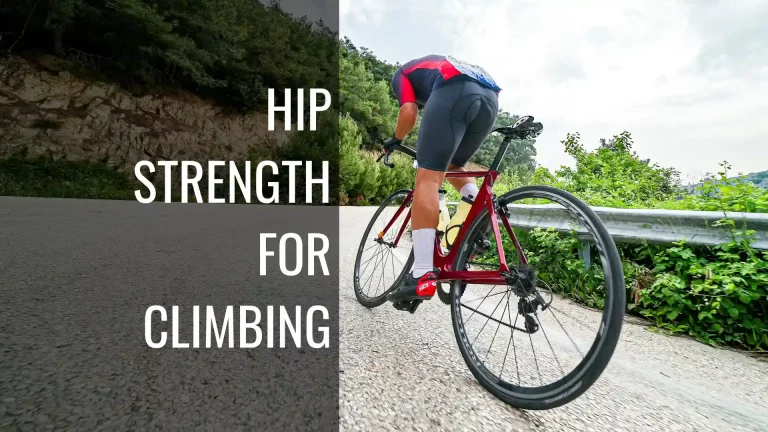My Trek 4300 Bike – reliable, dependable, and versatile – my riding partner for 20 years.
When John Burke and Richard Burke founded Trek Bicycle Corporation in a humble red barn in Waterloo, Wisconsin, back in 1976, they had a simple yet revolutionary vision: build bicycles that would inspire riders to push beyond their limits. Nearly five decades later, that same spirit of innovation and adventure lives on in every Trek bike that rolls off the production line, and nowhere is this more evident than in the versatile, dependable Trek 4300.
I got my Trek 4300 mountain bike in 2004. Nearly 20 years ago. In those two decades, I accumulated quite a few bikes, including a road bike, a full suspension fork mountain bike, and recently got a gravel bike.
Frame sizes and form are crucial for creating memorable trail rides. The Trek 4300, with its large frame clearance and Shimano rim brakes, has led me to the fulfilling adventures of off-road cycling, helped me bond with my son, and acted as a gravel crusher. In its rite of passage, this classic, versatile mountain bike is now going to be ridden by my son. The Trek 4300 will be his first real mountain bike and his access to a world of adventure, speed, and discovery.
Within this post, you’ll learn more about my riding experiences with the Trek 4300 Mountain Bike, its components, and its performance across various terrains.
The Trek 4300: My Introduction
I learned to cycle when I was about 5, and I always had a bike growing up. But college and jobs kept me from continuing to ride. I had given my cycle away at some point. On a whim, a friend and I decided to get a new mountain bike.
The goal was for me to restart my passion for riding bikes, and for him to get into cycling. I remember walking into a Ski Barn (not sure why) to get the Trek 4300. The price was about $400. It was nighttime when I arrived home with my brand new bike.
The next day, after work, I took my bike out for my first ride around my neighborhood. The familiar feeling of wind on my face and the nostalgia of freedom brought back memories of my younger days. Little did I know this would be the beginning of a lifelong obsession with anything cycling.
My next step was to challenge myself more and hit the trails near my house. I have two types of trails – a hard-packed gravel trail that runs along the river/ stream for almost the entire state of New Jersey. This is mostly a flat bike path.
The other option for riding my Trek 4300 is a more serious off-road trail experience featuring challenging rocks and roots. At first, I was not aware of the off-road trail. I hit the flat ones frequently.
But repetition leads to boredom. So it was by accident that I discovered the off-road trail. I saw other cyclists going to the other side of the parking lot. Didn’t pay too much attention to them.
Once the urge to seek excitement and adventure struck, I ventured through the bushes and discovered a completely different landscape. This would be the start of my own adventure with my Trek 4300 bike.
Connecting with My Son Via the Trek 4300
My wife sometimes cycles with me. She may not be as adventurous as I am when off-road cycling through rocks and roots, but she likes to ride on gravel and loose dirt. So she got a used mountain bike, and we both went on many memorable rides, navigating our local trails. We even took the bike with us during trips.
I gained another partner when my son was about 4 years old. It started with him riding on a kid seat behind me on the Trek 4300. Those days are some of my most memorable. The Trek 4300 mountain bike was the scene for so many of my cherished memories

Trek 4300: Versatile Power
Kids grow up fast! Around the time he got too big to fit the kid seat, I was getting interested in gravel bikes.
I really did not want to spend on a new bike. By this time, I had my Specialized Stumpjumper as well. I didn’t need a new, dedicated hardtail for mountain bike trails. Besides, the aluminum frame and components of the Trek 4300 were still in good condition.
I modified the 4300 into a gravel bike, or rather, a monster-cross bike. I installed drop bars and brakes from my Trek road bike. (Check out how I converted the Trek road bike into a single speed as a side project)
Trek 4300 Stock Components: Brakes, Gears, and Shifter
The components are basic, but very well-built. The Trek 4300 comes with the following:
- Cantilever brakes, with enough power to stop on steep descents
- The stock 8-speed gear for riding power
- Shimano Alivio rear shifter, in which I found the shifting to be “laggy” than my Shimano XT shifter on the Specialized Stumpjumper, but that is to be expected from a 20-year-old bike.
It was during the conversion to monster-cross that I figured out how compatible Shimano’s transmission systems were between road and mountain bike setups with the same “pull ratios”- but only up to 9 speeds. Since my Trek 4300 was an 8-speed entry-level mountain bike (I was soon to add a new cassette to make it 9-speed), and my Trek road bike was a 9-speed, the gearing would work with the new shifters.
I put in a new goat-link adapter from Wolftooth components. The adapter provides the rear derailleur with more clearance to cover the big cassette’s low gearing. So, along with the drop bars, road bike brifters, and the added gearing, I had transformed the Trek 4300 into more of a cross between a gravel and mountain bike.



In its monster-cross form, I had put in close to 500 miles on the Trek 4300 over the course of 2-3 years. I took the bike on numerous mountain bike and gravel trails. It was a lot of fun, amplified by the satisfaction that this was something I built for my specific riding style and riding performance needs. A point to note is the quality of the bike and it stock components.
The only Trek 4300 component I changed a few years ago was the bottom bracket and cranks. I never had any issues with anything else, even after “transforming” the bike a couple of times. These old bikes are built for durable performance and to last several decades over hundreds of rides across tough terrain.
The Trek 4300 Rides into the Future
My son is at an age where he needs his own bike. Giving him this old 26″ aluminum frame bike, which to some is too old to pass down, helps him see the simplicity of a basic mountain bike as he identifies and develops his style of riding.
He has many more years and decades to get the bike of his choice. But think the Trek 4300 is a very good starter bike he can use and his riding skills on the saddle. I changed the monster cross back to its original mountain bike form for him to start riding with me on the trails. See the newly updated Trek 4300 below.

Trek 4300 FAQ
Model Specifications & Components
What was the Trek 4300’s frame construction and geometry design philosophy?
The Trek 4300 featured an Alpha Aluminum frame with Trek’s optimized tube shaping for strength-to-weight efficiency. The geometry was trail-oriented with a slightly relaxed head tube angle (around 70-71°) and moderate chainstay length, positioning it as a recreational hardtail rather than an aggressive XC race bike like the Trek 6000 series.
How does the 4300’s suspension fork compare to what came on the Trek 4500 or 4900?
The 4300 typically came with entry-level suspension forks (SR Suntour XCT or similar) with 80-100mm travel and coil springs. The 4500 moved up to air-sprung forks with lockout, while the 4900 featured higher-end RockShox or Fox units with better damping and adjustability. The 4300’s fork was adequate for light trail use but lacked the tunability serious riders expect.
What drivetrain configurations were available across different model years?
Earlier 4300s ran 3×8 or 3×9 drivetrains with Shimano Alivio or Acera components. Later models transitioned to 2×9 or 2×10 setups. This contrasts with contemporary Specialized Rockhopper or Giant Talon models that followed similar progression patterns in the entry-hardtail category.
Performance & Riding Characteristics
How does the 4300’s trail performance compare to bikes like the Specialized Hardrock or Giant Boulder?
The 4300 slots similarly to those models—capable recreational hardtails for light trail riding, gravel paths, and fitness riding. All three prioritize durability and comfort over weight savings or aggressive geometry. The Trek’s Alpha Aluminum was competitive with Giant’s ALUXX and Specialized’s A1 aluminum in this price bracket.
Can the Trek 4300 handle technical singletrack, or is it better suited for fire roads?
The 4300 can handle moderate singletrack but wasn’t designed for chunk or steep technical features. The fork’s limited travel and damping, combined with relaxed geometry, make it more confident on smoother trails. Riders tackling serious technical terrain would benefit from stepping up to a Trek X-Caliber or Marlin with better componentry.
What’s the realistic weight range for a Trek 4300, and how does that affect climbing?
Depending on model year and size, expect 28-32 lbs. That’s typical for entry-level hardtails but noticeably heavier than XC-oriented bikes like the Trek Superfly or Specialized Epic. The weight is manageable on moderate climbs but becomes a factor on sustained steep ascents where lighter bikes excel.
Upgrades & Modifications
What are the most impactful upgrades for a used Trek 4300?
Prioritize contact points first: quality grips, saddle, and pedals make immediate differences. After that, tires are huge—replacing stock rubber with tubeless-ready tires like Maxxis Ikon or Schwalbe Racing Ralph improves traction and rolling resistance dramatically. A dropper post adds trail capability if the frame has internal routing.
Is it worth upgrading the fork on a Trek 4300, or should I just buy a better bike?
If the frame fits well and you’re happy otherwise, a fork upgrade to something like a RockShox Recon or SR Suntour Epixon (around $300-400) can transform the ride quality. However, spending more than that approaches used bike territory where you could find a Trek Marlin or X-Caliber with better overall spec.
Can I convert a Trek 4300 to 1x drivetrain, and what challenges should I expect?
Absolutely. Remove the front derailleur and small chainring, install a narrow-wide chainring (28-32T depending on terrain), add a clutch rear derailleur if needed, and optionally use a chain guide. The main challenge is ensuring you have adequate gear range—the stock cassette may not have a large enough cog for steep climbs without the granny gear.
What’s the maximum tire clearance, and can I run plus-size tires?
The 4300 typically accommodates up to 2.3″ tires comfortably, possibly 2.4″ depending on rim width and tire casing. Plus-size (2.8-3.0″) is unlikely without significant modification. For comparison, Trek’s Roscoe was purpose-built for plus tires, while the 4300 stays traditional.
Comparison with Other Models
How does the Trek 4300 compare to the Trek Marlin series?
The Marlin replaced the numbered series (3000/4000/etc) in Trek’s lineup. A modern Marlin 5 or 6 is essentially the spiritual successor to the 4300, with updated geometry, better component integration, and features like internal cable routing and thru-axles that the 4300 lacked.
Would a Trek 3700 or Trek 820 owner notice significant differences upgrading to a 4300?
Yes, the jump from the 3700 or 820 to the 4300 is noticeable. Better frame material, improved component spec, and more refined geometry make the 4300 feel livelier and more capable on trails. That said, the difference isn’t as dramatic as jumping to Trek’s X-Caliber or Fuel EX series.
How does the 4300 stack up against contemporary Cannondale Trail or GT Aggressor models?
These bikes compete in the same entry-hardtail segment. Cannondale Trail models offered similar aluminum frames with slightly sportier positioning, while GT Aggressors emphasized durability. Component spec varied by year, but performance-wise, they’re all comparable recreational mountain bikes with similar strengths and limitations.
Maintenance & Longevity
What are common wear points or failure modes on aging Trek 4300s?
Watch for worn pivot hardware where the rear triangle meets the frame (if equipped with rear suspension), headset bearing wear, and bottom bracket creaking from frame face wear. The fork bushings on entry-level suspension often wear quickly, causing stiction. Wheel bearings and freehub pawls also see accelerated wear on bikes that see regular trail use.
Are replacement parts readily available for 10-15-year-old Trek 4300s?
Yes, generally. Since the 4300 used standard threading and common component standards, most parts are easily sourced. The main exception is if you need frame-specific parts like derailleur hangers—Trek’s support is good, but older models may require hunting. Wheels, drivetrain, and cockpit components are standard replacements.
How often should I service the fork on a Trek 4300, and is it DIY-friendly?
Entry-level coil forks need basic lowers service (wiper seals and oil) annually or every 50-100 hours. DIY is manageable with basic tools and fork-specific guides. However, damper service requires more skill. Given the fork’s value, many riders skip deep service and replace the fork entirely when performance degrades significantly.
Fit & Sizing
How does Trek’s Alpha sizing translate, and what size should a 5’10” rider choose?
Trek’s sizing evolved over the years, but generally, a 5’10” rider fits a 17.5″ or 18.5″ frame (medium/large). The 4300’s relaxed geometry means going slightly larger is comfortable for casual riding, while XC-focused riders might prefer the smaller size for maneuverability. Modern geometry has slackened and lengthened considerably compared to these older standards.
Can I run a longer stem to make the 4300 fit more like an XC race bike?
You can, but it’s fighting the bike’s design intent. The 4300’s geometry with its steeper seat angle and shorter reach was designed around moderate stem lengths (70-90mm). Going much longer affects handling negatively. If you want XC positioning, consider a Trek Procaliber or older Trek Elite series instead.
Market & Value
What’s a fair price for a used Trek 4300, and what condition should I expect?
Market value depends heavily on age, condition, and components. Expect $150-350 for bikes from the mid-2000s to early 2010s. Compare against equivalent-era Specialized Rockhopper, Giant Talon, or Cannondale Trail models. Check for frame damage, pivot wear, and whether components are original or upgraded. At the higher end, expect newer models with minimal wear.
Is a Trek 4300 a good platform for a budget bikepacking setup or gravel conversion?
It’s viable but not optimal. The geometry and weight aren’t ideal for long-distance efficiency, and mounting points are limited compared to modern touring or bikepacking-specific frames. That said, it can work with frame bags, seat packs, and handlebar rolls. A Trek 520 or Checkpoint would be purpose-built alternatives, while a Trek 930 or 950 vintage MTB offers similar conversion potential with better mounting options




[…] had recently written about my old Trek 4300, and how I am passing it on to my son. So he has his own mountain bike now. I foresee him using his […]
[…] seats for years. So that was the first upgrade I did from the stock seats, when I moved it from my monster-cross bike that I built. If you are in the market for a new bike seat, check out our Ask The Pedalist post on how to make […]
[…] own a few bikes – a 2004 Trek 4300 hard tail mountain bike, a 2011 Specialized StumpJumper FSR mountain bike, a 2014 Cannondale […]
[…] have a total of 5 cycles – 2 mountain bikes (Trek 4300 and Specialized), 2 road bikes (Trek 1.2 and Cannondale) and 1 gravel bike (Poseidon X). Except […]
[…] and ridden it over roots and rocks, and even taken it with me when traveling. I had also converted it to a gravel bike, where it shined as a true all rounder, on gravel, rocky trails, and on the road. It’s well […]
[…] I bought it. My mountain and gravel bikes are aluminum frames, and have lasted me years, my Trek 4300 going strong even after to 20 years. If money waere not a concern, all my bikes would be carbon […]